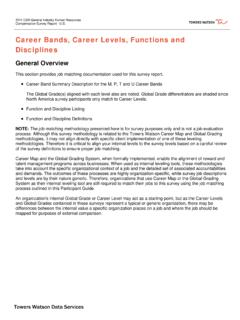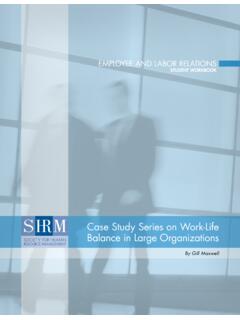Transcription of Discretionary Employee Benefits - SHRM
1 Discretionary Employee BenefitsBy Karen S. Markel, , SPHRTo Tal REwaRDs instructor s ManualPROJECT TEAMA uthor: Karen S. Markel, , SPHRSHR M project contributor: Bill Schaefer, SPHR, CEBSE xternal contributor: Sharon H. LeonardCopy editing: Katya Scanlan, copy editorDesign: Shirley Raybuck, graphic designer 2010 Society for Human Resource Management. Karen S. Markel, , SPHRNote to HR faculty and instructors: SHR M cases and modules are intended for use in HR classrooms at universities. Teaching notes are included with each. While our current intent is to make the materials available without charge, we reserve the right to impose charges should we deem it necessary to support the program.
2 However, currently, these resources are available free of charge to all. Please duplicate only the number of copies needed, one for each student in the more information, please contact:SHRM Academic Initiatives 1800 Duke Street, Alexandria, VA 22314, USA Phone: (800) 283-7476 Fax: (703) 535-6432 Web: 10-0667 2010 society for Human Resource Management. Karen s. Markel, , sPHR 1 InTROduCTIOnThis module provides a foundation in Discretionary Benefits with a focus on design and implementation issues; health and medical Benefits ; and retirement module is appropriate for upper-level undergraduate or graduate students as part of an introduction to a human resource management or Employee Benefits OuTCOMEsAt the end of this module, students will be able to: nIdentify issues in Discretionary Benefits design and implementation.
3 NDefine the types of Discretionary Benefits . nIdentify the relationship between various Discretionary Benefits programs and relevant federal law. LEARnIng MOduLE sTRuCTuREThis learning module comprises three class sessions. Session 1 will take 55 minutes to complete, Session 2 will take 80 minutes to complete, and Session 3 will take 60 minutes to complete. The suggested times include class lecture but not exercise or assessment time. Each session includes the following instructional materials:1. instructor s guide: nSupplemental material suggestion(s). nAssessment questions.
4 NExercise(s).2. PowerPoint slidesInstructor s GuideThe instructor s guide provides a suggested format and schedule for conducting each session and suggestions for supplemental material, assessment questions and exercise(s).Instructional Materials2 2010 society for Human Resource Management. Karen s. Markel, , sPHRA ssessment QuestionsPlease note that these questions are not included in the suggested timeline because their use will vary by QuizzesEach session includes a true-or-false quiz with answers. The questions are based on the content from each session. Depending on how the session is structured, these can be used as a class pre-test or post -test QuestionsThe instructor s guide includes three discussion questions per session; these questions can be used for discussion during the presentation, as a way to summarize the material or as an session includes suggested exercise(s) that may be used as part of the presentation or as a homework assignment.
5 PowerPoint SlidesThe PowerPoint file for this module includes lecture notes in the Notes section. The PowerPoint slides can be distributed to students as a reference manual for the module. The instructor may want to distribute the slides as handouts (three per page), so students can follow along and write additional notes in the space MATERIAL Suggested additional material is included with each session to supplement to the instructor s notes and PowerPoint slides. In general, the following basic Benefits textbooks and web sites are good resources for this module:1.
6 Martocchio, J. J. (2008). Employee Benefits : A primer for human resource professionals, 3rd ed. New York: McGraw-Hill Higher Murphy, T. E. (2009). Benefits and beyond: A comprehensive and strategic approach to retirement, health care, and more. Thousand Oaks, CA: Sage Rosenbloom, (2005). Handbook of Employee Benefits , 6th ed. New York: SHR M Benefits Discipline web page: / 5. SHR M. (2010). 2010 Employee Benefits : Examining Employee Benefits in the midst of a recovering economy. Alexandria, VA: SHR M. 2010 society for Human Resource Management.
7 Karen s. Markel, , sPHR 3sEssIOn OVERVIEWsSession 1: Design and Implementation Considerations for a Discretionary Benefits ProgramThis session introduces students to the challenges in determining what Benefits to offer; how to make them available to employees; how to communicate Benefits information; and how to determine if a Benefits program is effective. Suggested exercises include gathering benchmarking information and completing a SHR M case study. Although not included in the PowerPoint slides, there is an additional exercise that incorporates the suggested case for this class 2: Health and Medical Insurance Benefits This session discusses Benefits that address employees health and medical needs ( , major medical, dental, vision).
8 Various plan types and administration issues are introduced. Key provisions of the Consolidated Omnibus Budget Reconciliation Act (COBR A) of 1986 and the Health Insurance Portability and Accountability Act (HIPA A) of 1996 are also considered as they relate to health and medical Benefits . The exercise in this session challenges students to analyze data from the Bureau of Labor Statistics (BLS) National Compensation 3: Retirement BenefitsThis session explores basic retirement benefit plans. Included in this discussion is the relationship among the Social Security Act of 1935, the Employee Retirement Income Security Act (ERISA) of 1974, the Internal Revenue Code and the Pension Protection Act of 2006.
9 The exercise for this session requires students to analyze fact sheets from the Employee Benefit Research Institute s Retirement Confidence 2010 society for Human Resource Management. Karen s. Markel, , sPHRThe following teaching notes, exercise and assessments accompany the PowerPoint slides for this TIMELInETopicPPT slide(s)Approximate timeIntroduction3-45 Benefits defined5-610 Benefits to offer7-1010 administration11-1210 effectiveness1410 25 minutes (Exercise 1)Assessment21-23 Not included in session timeExERCIsEsUsing Benchmarking DataTo remain competitive, employers like to gather information about what Benefits their competitors are offering their employees.
10 This exercise uses information from a SHR M benchmarking report on employer health care plans. The exercise requires students to interpret the results and gather information about how to use these data. Employers often gather benchmarking data when making decisions about what Benefits to offer, and this exercise illustrates some of the types of information that may be collected and used and what to consider when relying on this type of data. Note: Instructors may want to have students form groups of three to five to complete this exercise. The slides include detailed questions and relevant tables that students must review to answer the following questions:1.









